
Most springs, conversation at some point turns to no-till soybeans and how tough they look compared to their tilled counterparts. 2022 was no exception. With a record corn crop in 2021 and compaction due to a wet fall, there were challenges to contend with in no-till and some fields did get off to a slow start.
I followed five different no-till soybean fields throughout the 2022 growing season to see how they fared and to identify common challenges and keys to success. The key take-aways were:
- Seed soybeans at a higher rate (10-20%) to ensure an adequate stand under high residue conditions
- Consider seeding soybeans with a planter instead of a drill, especially when a chopping corn head is used
- Soybeans generally compensated for marginal stands with branching; they canopied in the first half of July and flourished in August
Despite challenges in some of the five fields, they yielded well overall, averaging over 61 bushels per acre. Economic analysis from the top-yielding field showed a gross margin (revenue – operating expenses) of $800 per acre. This demonstrates that no-till soybean production can be very competitive with tillage-based production when done as part of a conservation cropping system.
Read on for the full story.
Five fields, five stories.
I monitored five fields in southwestern Ontario, spanning three counties – Huron, Wellington and Brant. Crop heat units for the year totaled 3,114 at the Elora site versus 3,487 near Caledonia in Brant County. Each field had been under a reduced tillage system across the full rotation for 7 years or more (Table 1).
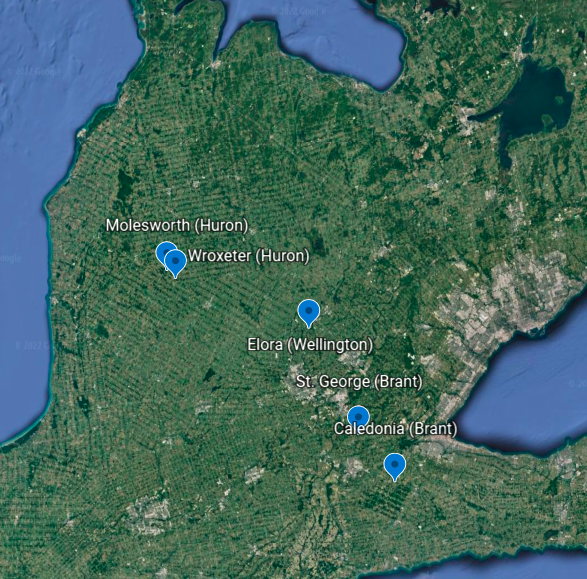
| Field | Soil series | Number of years in reduced tillage |
| Wroxeter (Huron) | Donnybrook Sandy Loam / Parkhill Loam / Harriston Loam | 23 |
| Molesworth (Huron) | Harriston Loam | 23 |
| Elora (Wellington) | Guelph Loam | 7 |
| St. George (Brant) | Brantford Silt Loam / Brantford Silty Clay Loam | 32 |
| Caledonia (Brant) | Haldimand Silty Clay / Haldimand Silty Clay Loam | 33 |
Fields were photographed in the same location in the months of June, July and August. Stand counts were performed across 5-10 locations in each field and averaged. Crop stage and height were recorded at each visit and yield was self-reported by cooperating farmers at the end of the season.
Field 1 – Wroxeter (Huron)
- Soybeans yielded 72 bu/ac following a 234 bu/ac grain corn crop harvested using corn head with Calmer chopping stalk rolls
- Seeded May 24, 2022 with a Case IH 2140 planter (no row cleaners) at 165,000 seeds/acre at 15-inch spacing
- Soybean variety: Altitude R2
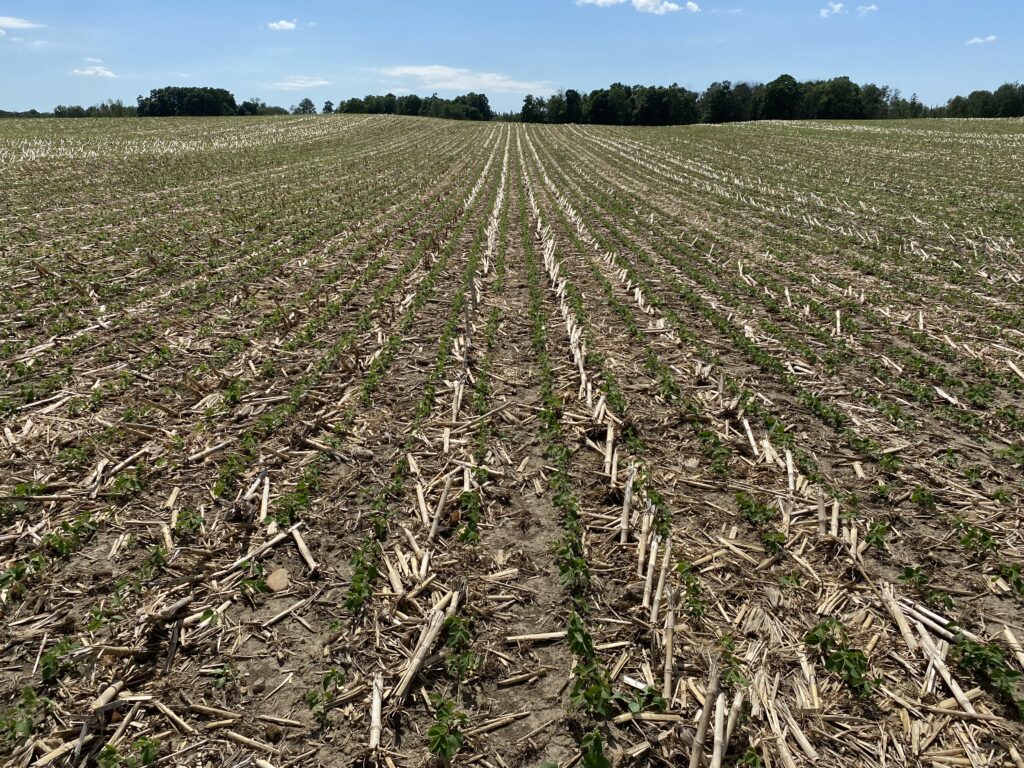

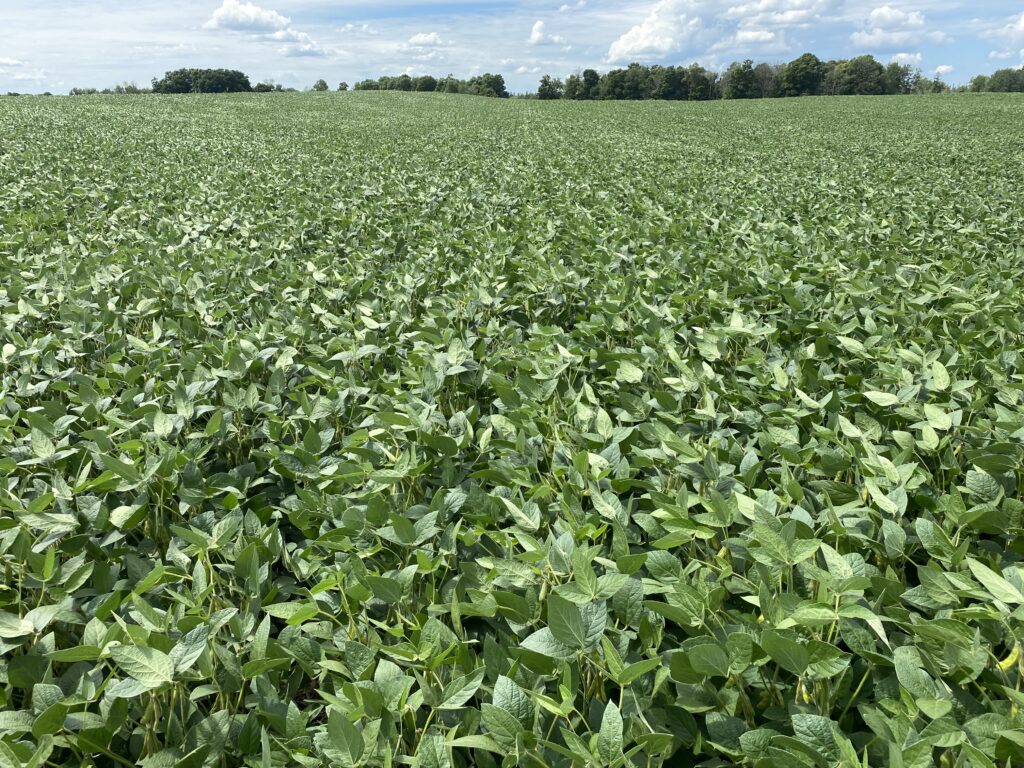
Stand count: 100,000 plants/acre
Final height: 33 inches
Field notes:
- Some gaps in soybean stand on old corn rows due to poor seed-to-soil contact.
- Spacing of 15-inch rows between old corn rows generally accurate.
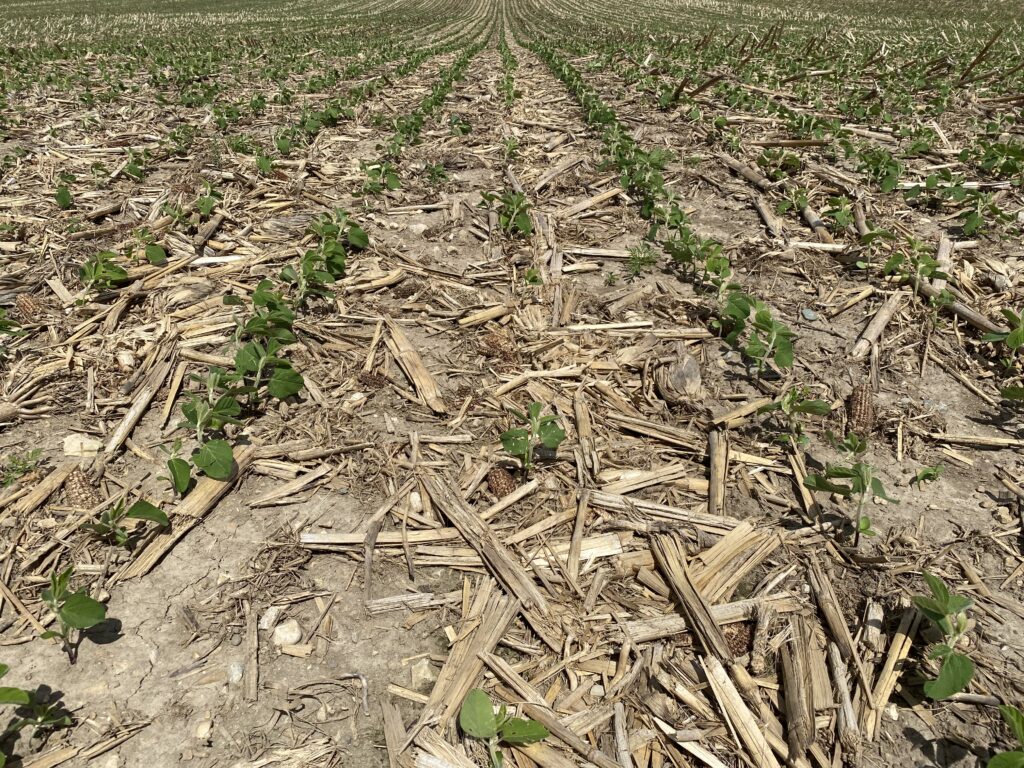
Field 2 – Molesworth (Huron)
- Soybeans yielded 68 bu/ac following 230 bu/ac grain corn crop harvested using corn head with Calmer chopping stalk rolls
- Seeded May 20, 2022 with a Case IH 2140 planter (no row cleaners) at 150,000 seeds/acre at 15-inch spacing
- Soybean variety: Altitude R2
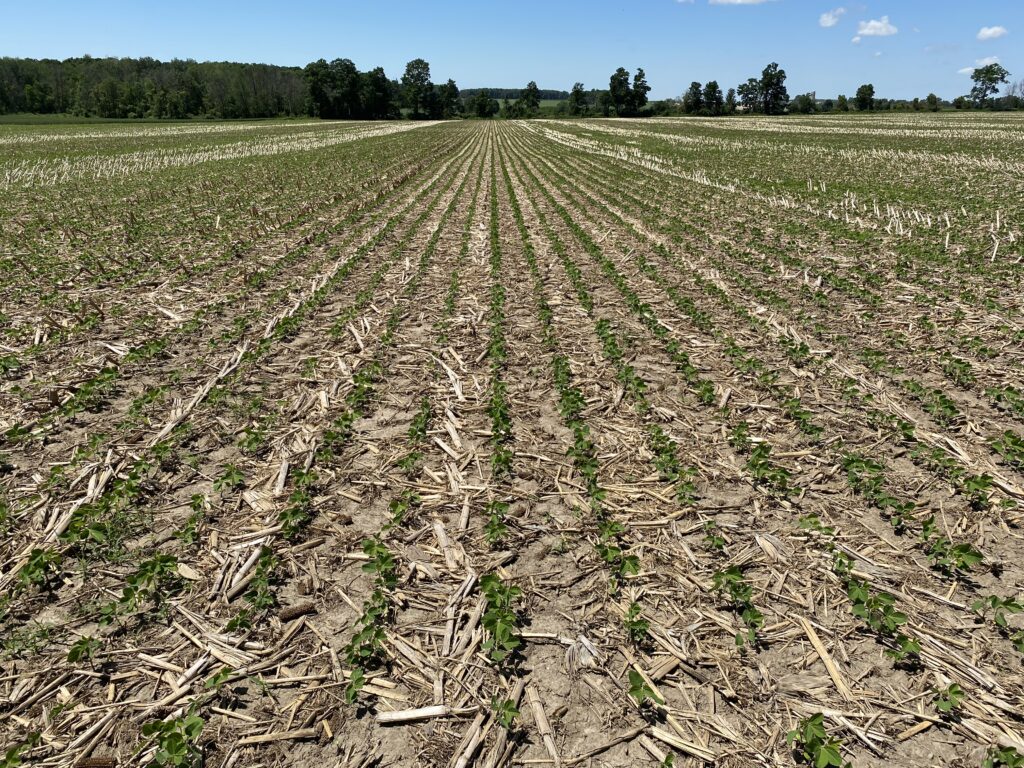
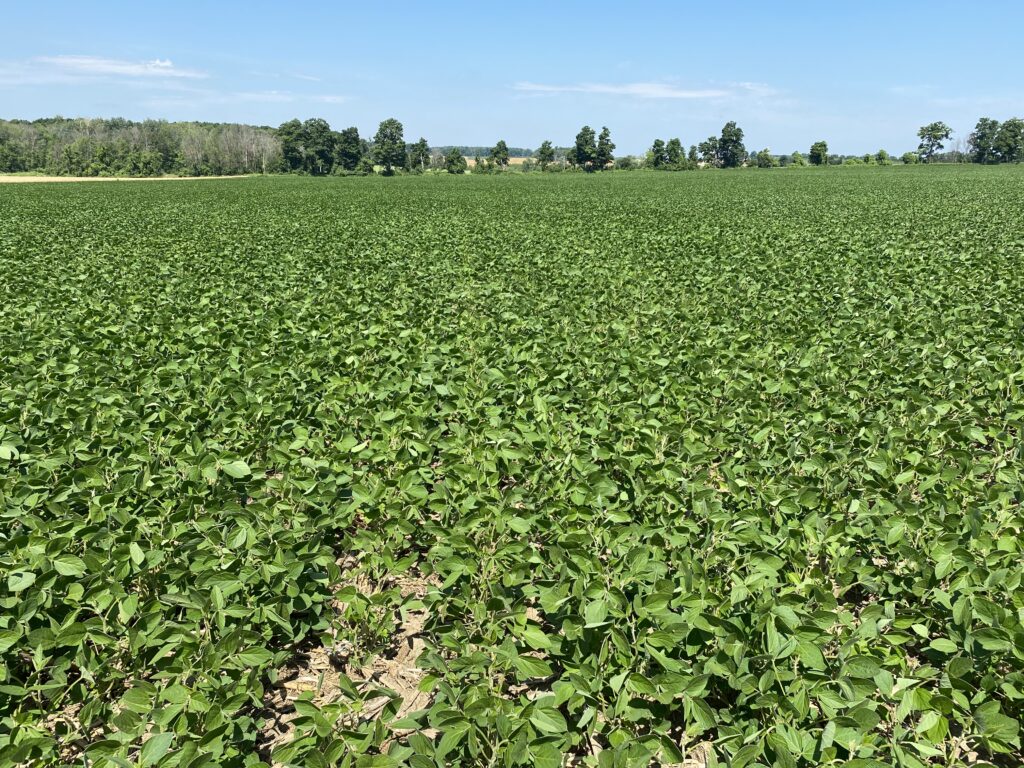
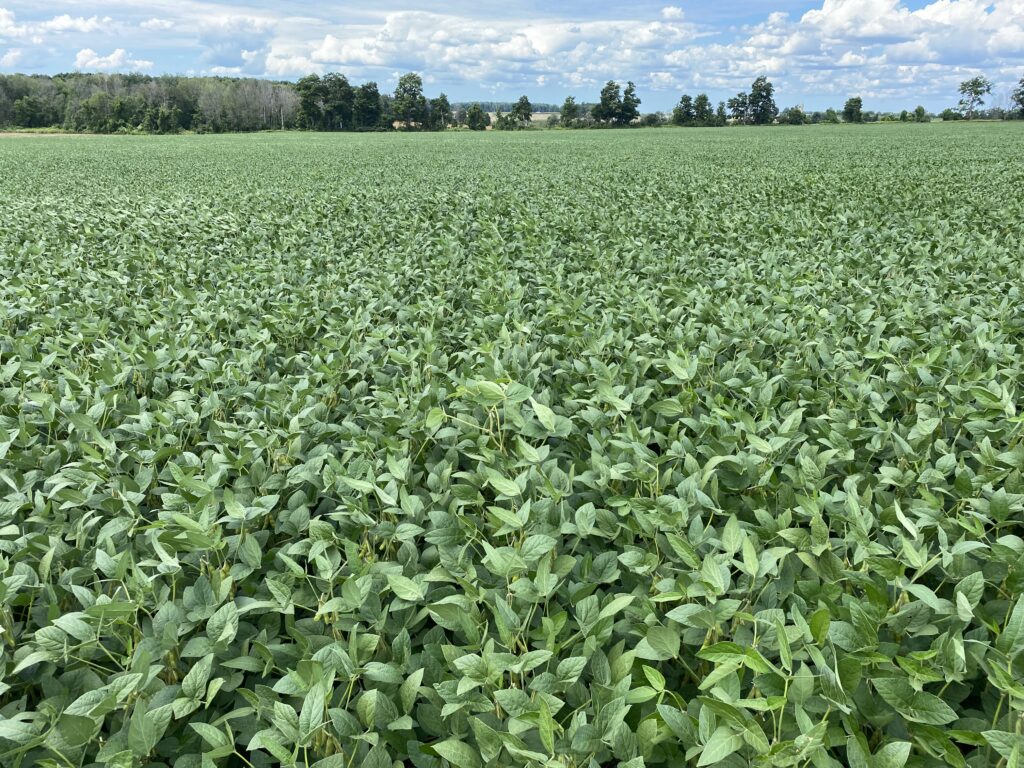
Stand count: 88,000 plants/acre
Final height: 27 inches
Field notes:
- Soil conditions fit at planting between corn rows, but not quite fit under corn rows due to residue. Resulted in some sidewall smearing.
- Marginal stand, due in part to soybean rows not well centered between previous corn rows. Soybeans seeded into corn rows emerged poorly due to wet conditions, poor seed-to-soil contact and suspected slug feeding.


Field 3 – Elora (Wellington)
- Soybeans yielded 64 bu/ac following 235 bu/ac grain corn crop harvested using corn head with Calmer crusher stalk rolls
- Seeded May 13, 2022 with a Kinze 3500 no-till planter (row cleaners on most row units) at 165,000 seeds/acre at 15-inch spacing
- Soybean variety: P09A53X
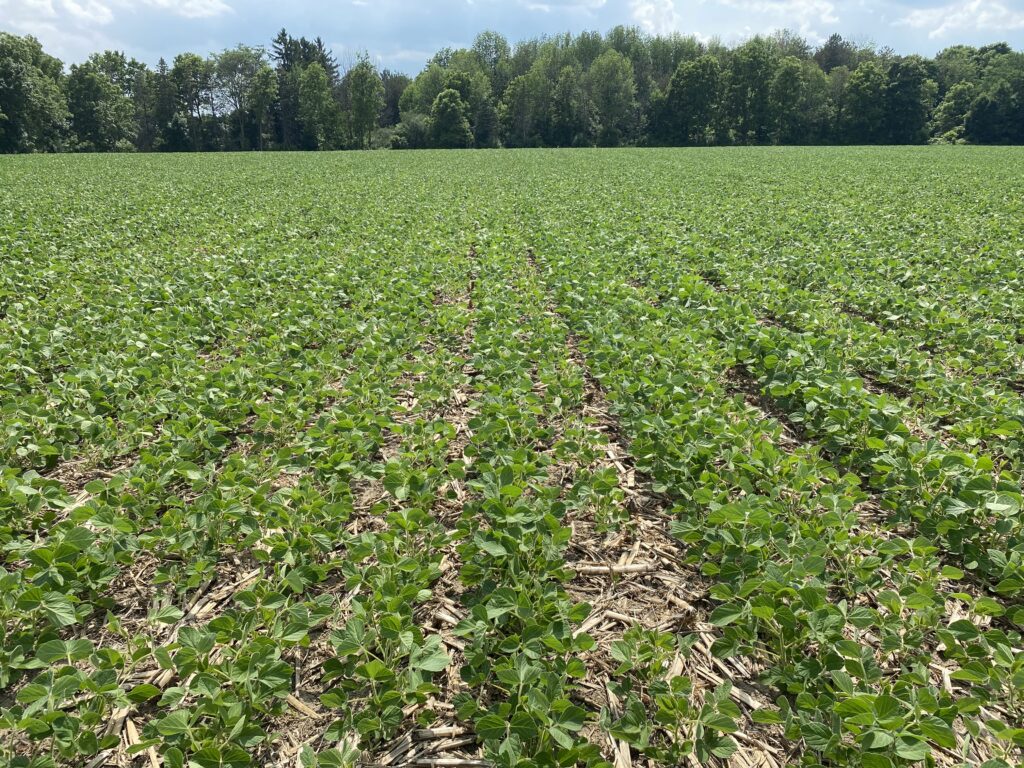
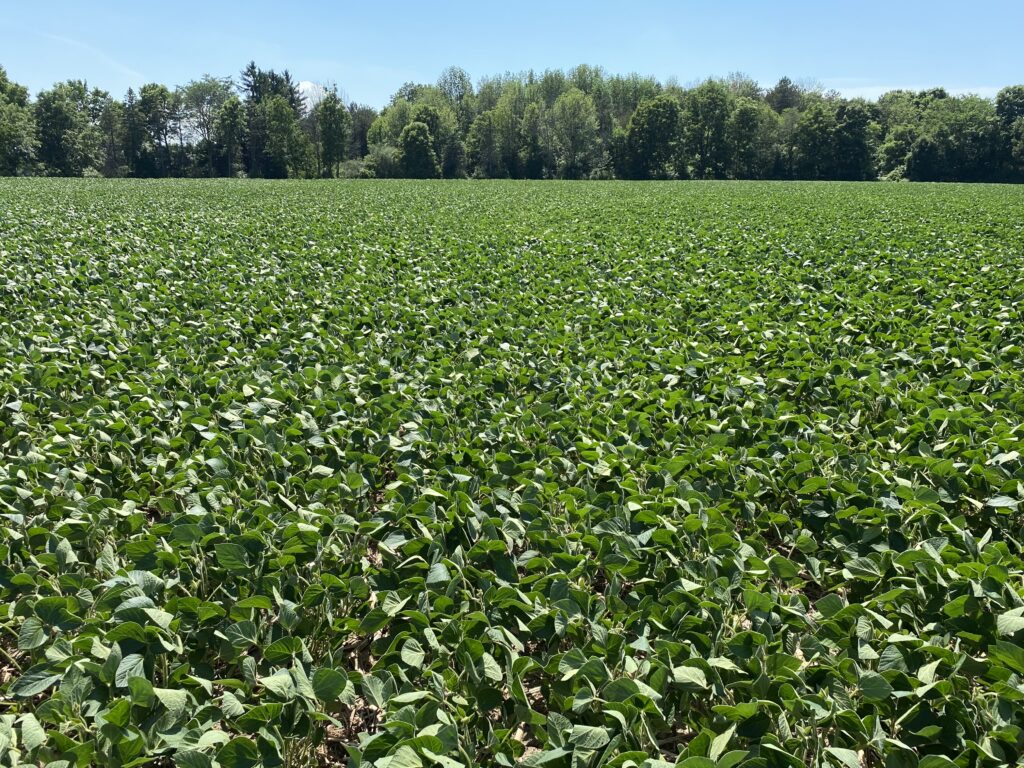
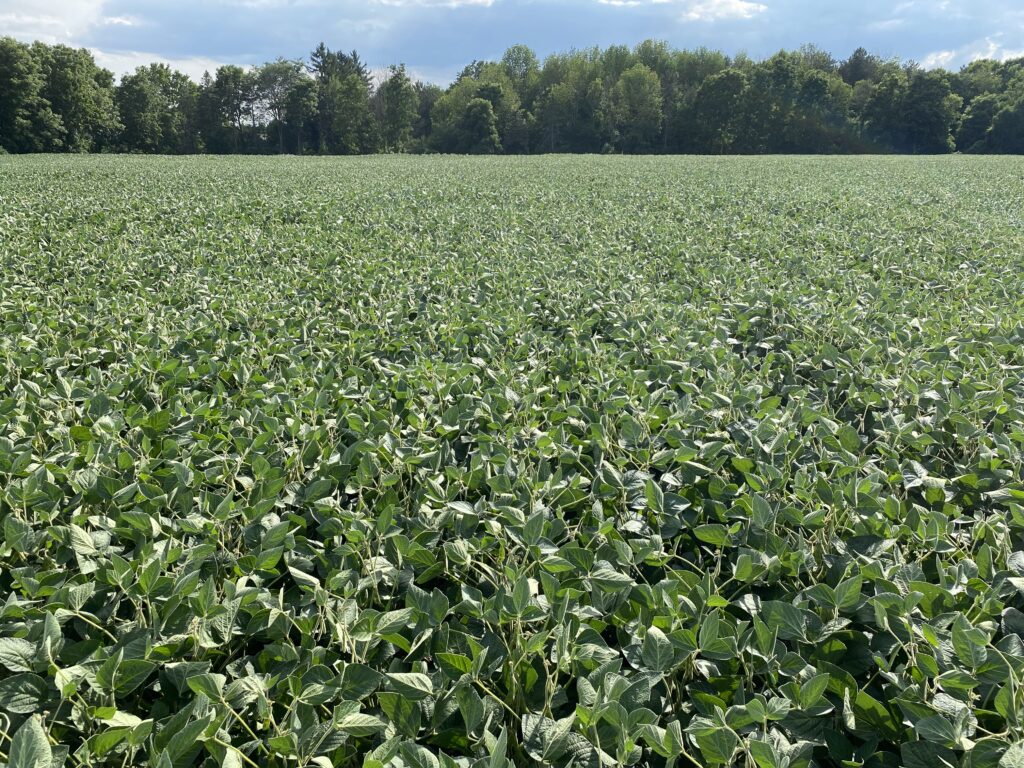
Stand count: 106,000 plants/acre
Final height: 29 inches
Field notes:
- Small gaps in stand due to heavy corn residue and poor seed-to-soil contact.
- Stand issues in alternating rows (see below) suspected by farmer to be present in rows from front gang, which had row units with only a single-wheel row cleaner or a wavy coulter vs. standard row cleaners plus wavy coulter on rear gang units.
- Gaps filled through soybean branching. Canopy closed and lush, dark green foliage by July.
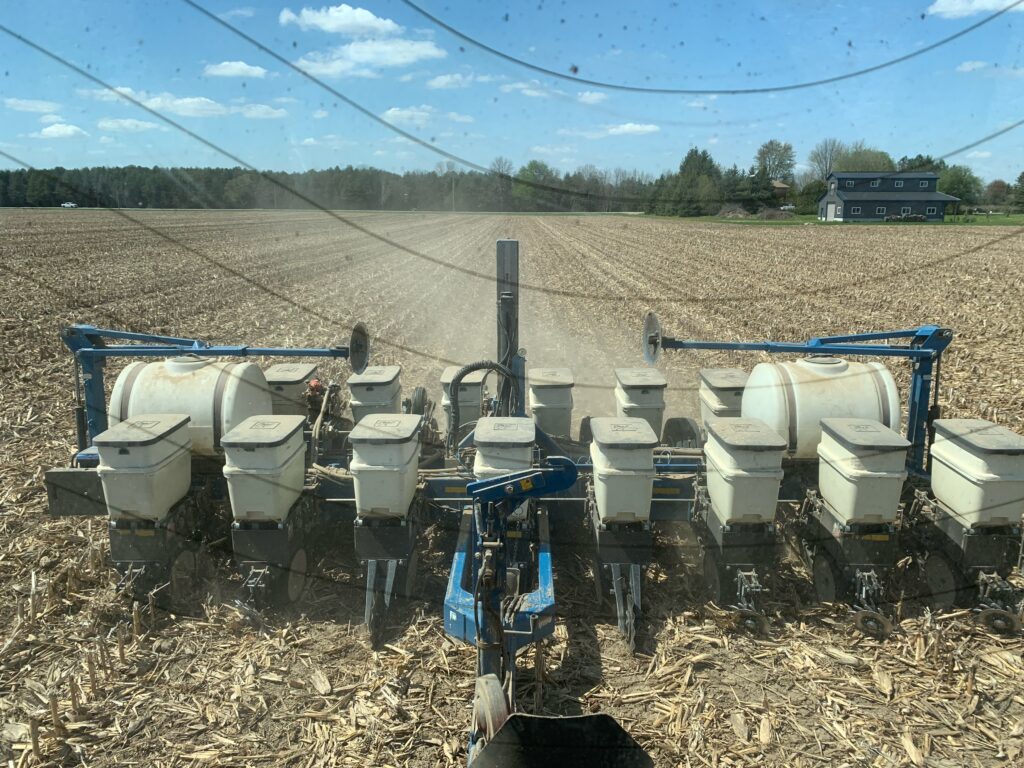
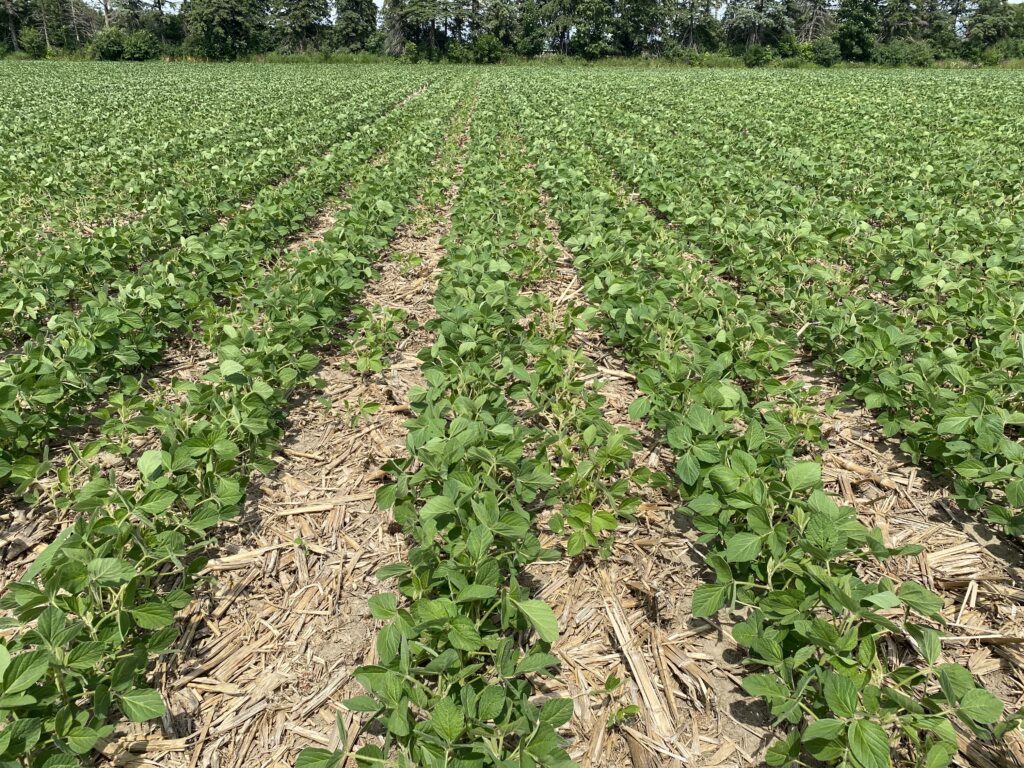
Field 4 – St. George (Brant)
- Soybeans yielded 50 bu/ac following 201 bu/ac grain corn crop harvested with Calmer chopping stalk rolls
- Seeded May 20, 2022 with a John Deere 1590 no-till drill at 155,000 seeds/acre at 15-inch spacing
- Soybean variety: NKS14U9X (66% of field) and P13A89 (34% of field)

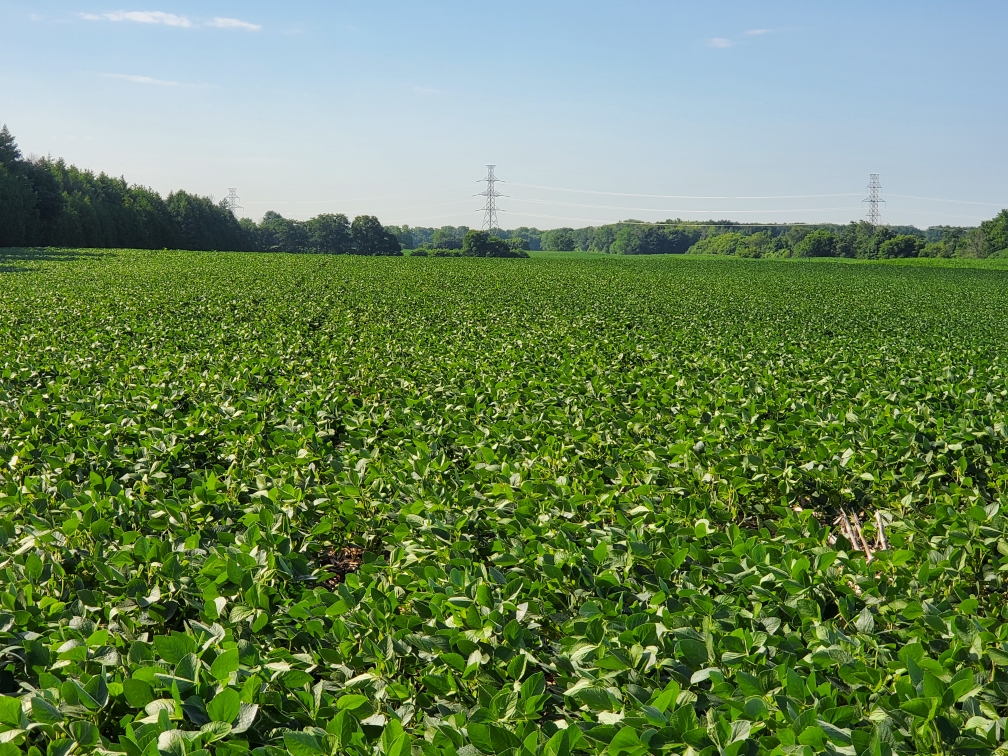
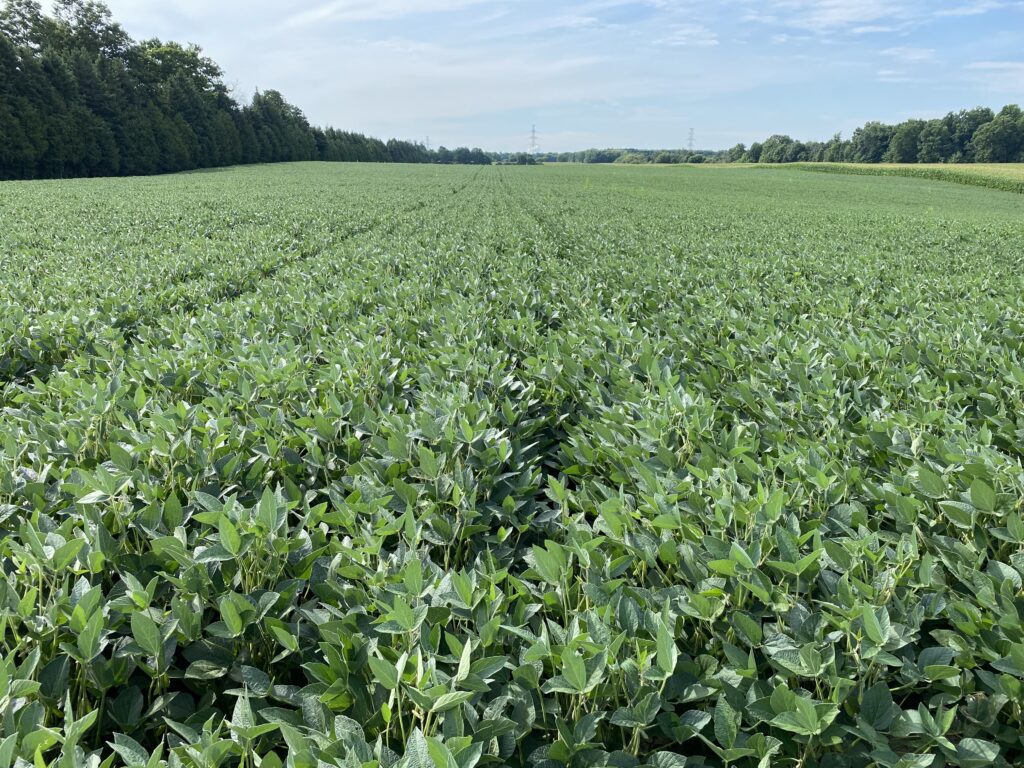
Stand count: 72,000 plants/acre
Final height: 34 inches (NKS14U9X)
Field notes:
- Ample corn residue present across entire surface of soil.
- No-till drill struggled to establish good seed-to-soil contact and close seed slot. Large gaps and a poor overall soybean stand resulted.
- Soybeans compensated with branching to fill gaps, but were not able to completely close canopy, even by August.
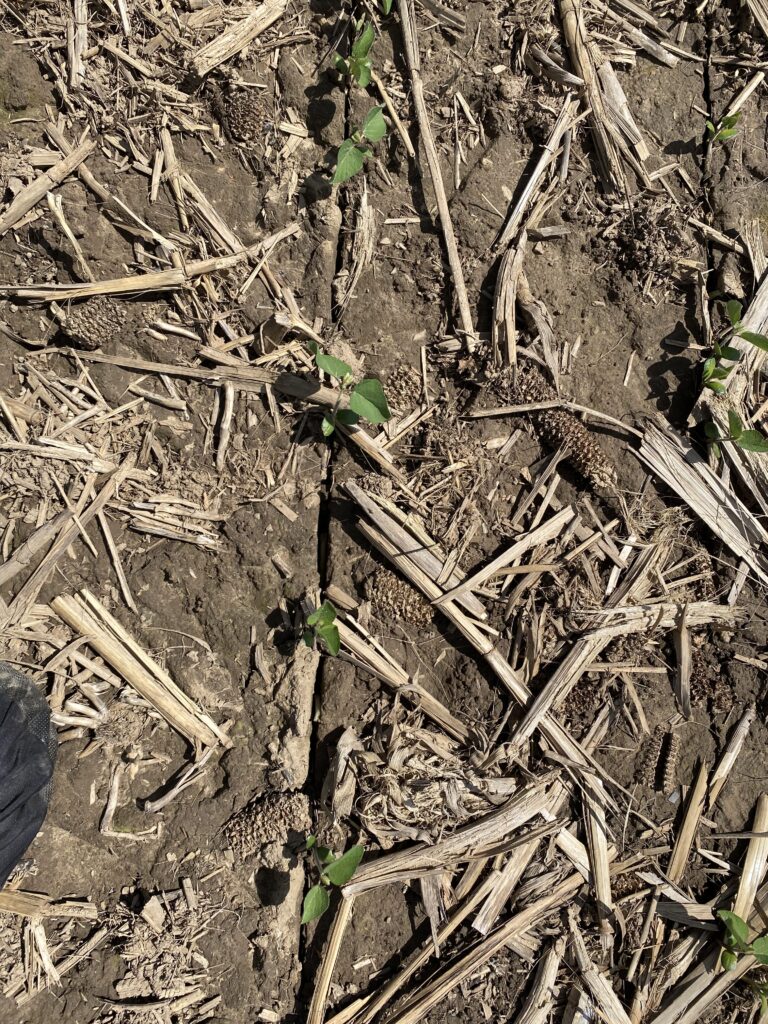
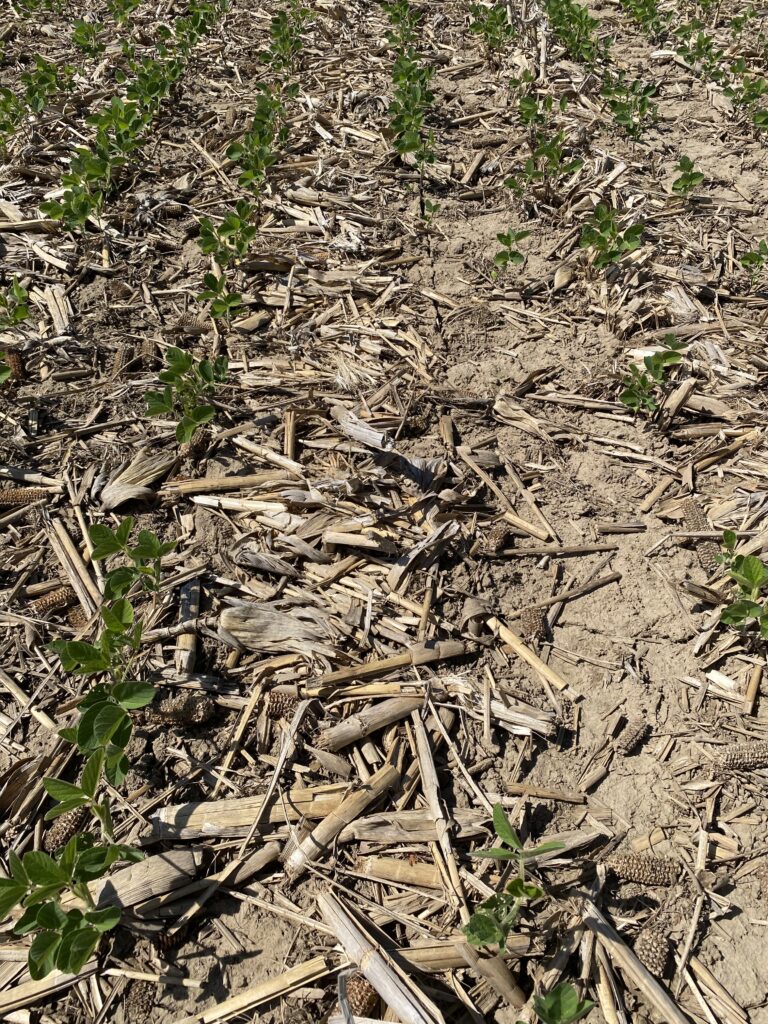
Field 5 – Caledonia (Brant)
- Soybeans yielded 52 bu/ac following 236 bu/ac grain corn crop harvested with non-chopping corn head
- Seeded May 26, 2022 with a John Deere 1890 air drill (no row cleaners) with 1910 cart at 200,000 seeds/acre at 7.5-inch spacing on angle to corn rows
- Soybean variety: NKS12M5X (62% of field) and DKB11-51 (38% of field)

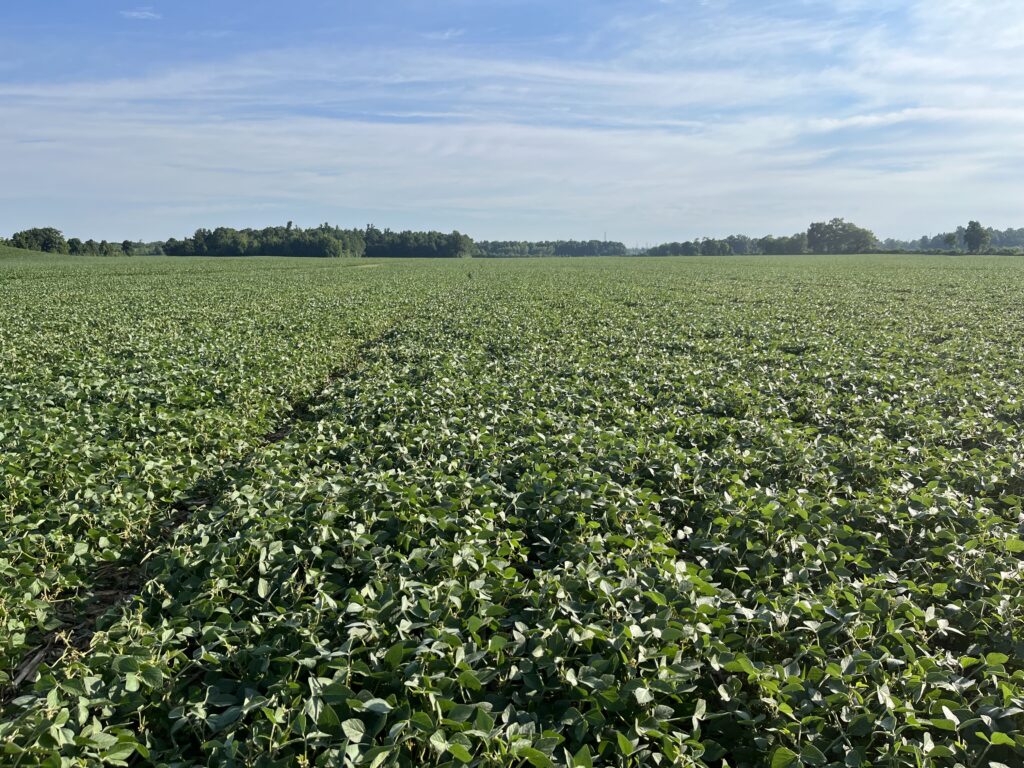
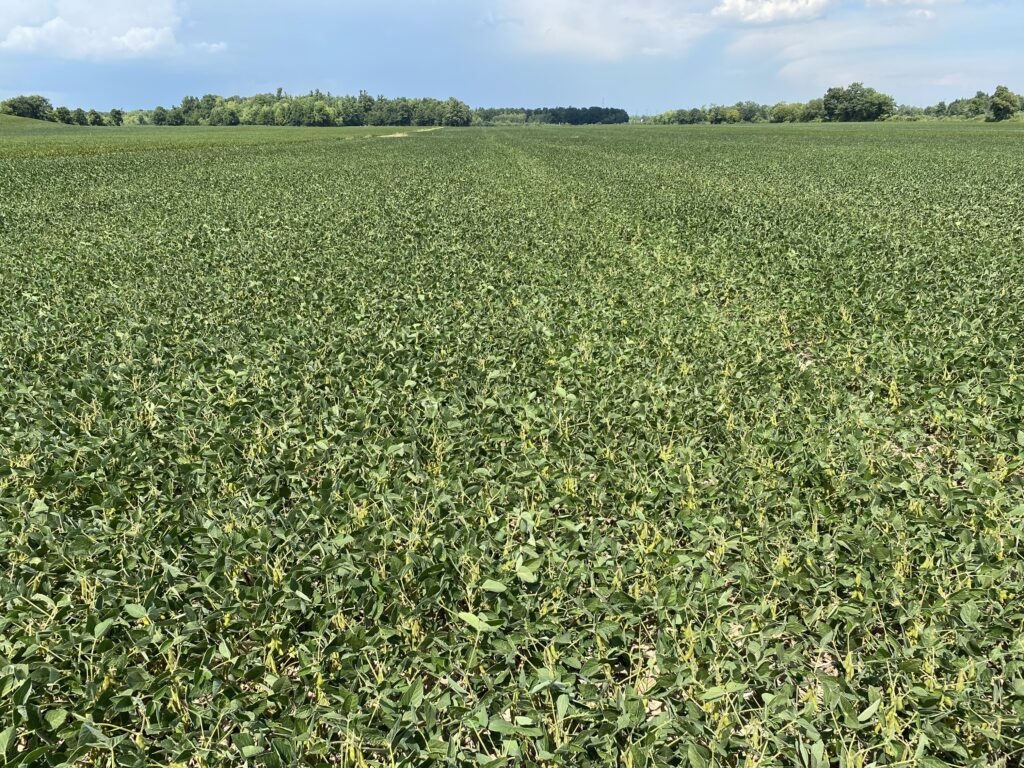
Stand count: 174,000 plants/acre
Final height: 16 inches (NKS12M5X)
Field notes:
- No major stand gaps observed; fully canopied and lush, dark green by July.
- Short stature of soybeans due likely to combination of soybean variety and heavy-textured soil.
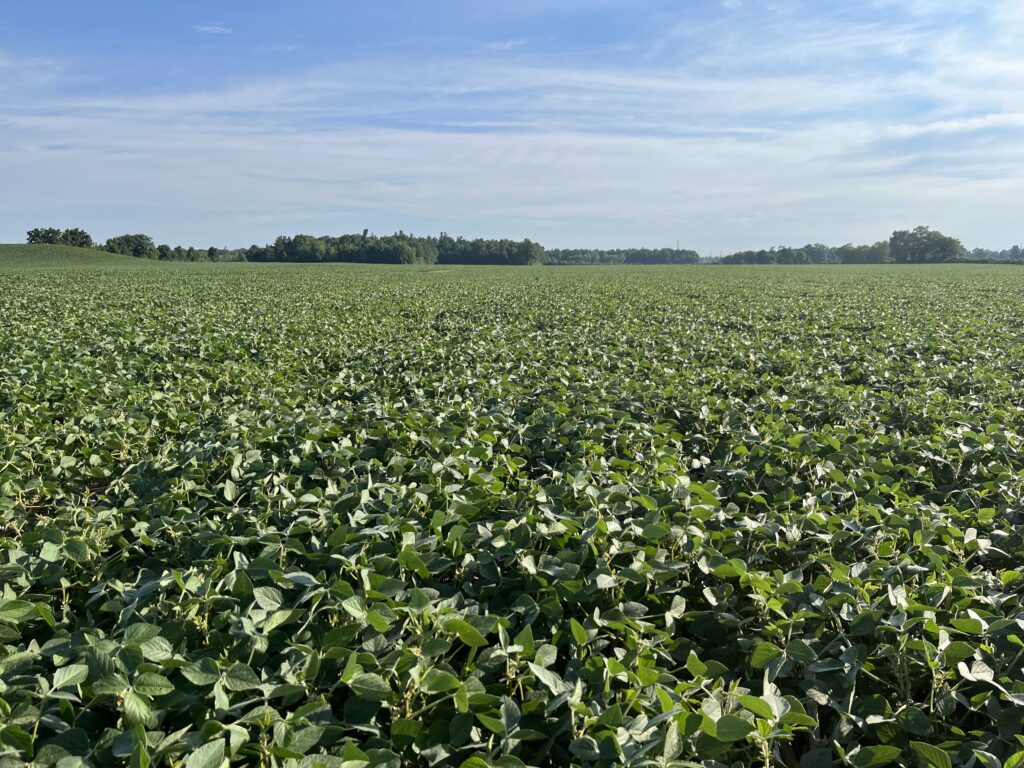
Plant stands and yields
The fields harvested using chopping stalk rolls (1, 2 and 4) had the lowest plant stands and the lowest percent plants emerged relative to seeding rate (Table 2). Field 5 – harvested with a non-chopping corn head – had the highest percentage of soybeans emerged. In the case of Field 4, the drill was not able to consistently achieve good seed-to-soil contact given the volume and distribution of corn residue. Past Ontario research has found that planters achieve better plant stands and yields when chopping corn heads are used.
Although four of the five fields had stands near or below 100,000 plants per acre, the soybeans generally fared well. Field 1 (Wroxeter) yielded the highest at 72 bushels per acre, followed by Field 2 (Molesworth) at 68 bu/ac and Field 3 (Elora) at 64 bu/ac (Table 2). Not surprisingly, Field 4 (St. George) yielded the lowest at 50 bu/ac, in part due to a thin stand, though it was also situated in the driest region all summer. On the heaviest and most challenging soil, Field 5 (Caledonia) finished at 52 bu/ac.
| Field | Plant stand (plants/acre) (% of seeding rate) | Yield (bushels/acre) |
| Field 1 – Wroxeter (Huron) | 100,000 (60%) | 72 |
| Field 2 – Molesworth (Huron) | 88,000 (59%) | 68 |
| Field 3 – Elora (Wellington) | 106,000 (64%) | 64 |
| Field 4 – St. George (Brant) | 72,000 (46%) | 50 |
| Field 5 – Caledonia (Brant) | 174,000 (87%) | 52 |
| Average | 107,800 | 61.2 |
Economics of no-till soybeans
The cooperating farmer for Field 1 – Wroxeter (Huron) shared his cost of production numbers (Table 3). The total operating expenses for Field 1 was $352 per acre. Based on these costs and a crop yield of 72 bushels per acre, the field provided a gross margin (revenue – operating expenses) of $800 per acre, assuming a soybean price of $16/bushel (Table 4). Even with a $12/bushel price, the field would have provided $512/acre. Overhead (fixed) expenses were not considered.
Although I have not provided a comparison to tilled soybeans, current OMAFRA cost of production figures show an additional operating cost of $23/ac in fuel and repairs/maintenance for conventional tillage soybeans, plus added labour. No-till typically carries slightly higher herbicide costs. Past Ontario research has shown little or no yield advantage to tillage before soybeans. The average yield gain to tillage for soybeans is about two bu/ac in Ontario.
Overall, no-till soybean production lowers input costs and can result in very strong returns, as seen in Table 4, assuming adequate stands are established in a timely fashion.
| Operating expense category | Expense | Field 1 – Wroxeter (Huron) costs ($/acre) |
| Seed | 78.54 | |
| Fertility | ||
| phosphorus | 25.00 | |
| potassium | 21.84 | |
| other nutrients applied | 11.00 | |
| Herbicide | ||
| annual grass and broadleaf weeds | 8.39 | |
| burndown | 29.63 | |
| Insecticide/Fungicide | 20.95 | |
| Tractor and machine expenses | ||
| fuel and lubricants | charged as custom work | |
| repairs and maintenance | charged as custom work | |
| Marketing board and Grain Financial Protection fees ($1.39/tonne) | 2.72 | |
| Production insurance | 9.19 | |
| Risk Management Program | 3.63 | |
| Drying, if required | 0 | |
| Custom work | ||
| pesticide applications | 33.00 | |
| fertilizer application, mixing and delivery | 0 | |
| planting | 38.00 | |
| packing | 9.00 | |
| combining | 58.00 | |
| Trucking | 3.5 | |
| Storage | 0 | |
| Land rent | 0 | |
| Total operating expenses | 352.39 |
| Total operating expenses | $352.39 |
| Yield (bushels/acre) | 72 |
| Price ($/bushel) | 16 (12) |
| Gross margin ($/acre) | $799.61 ($511.61) |
Key takeaways
As seen through these five fields, no-till soybeans can provide competitive yields and returns. They can also pose some management challenges, especially when it comes to establishing a strong stand. Three of the five fields followed had final stands of 100,000 plants per acre or below. Along with concerns around poor seed quality in 2022, it was clear that corn residue was responsible for issues with stand establishment across most fields. Corn headers that left more of the stalk intact in the row appeared to cause fewer seeding challenges.
The following are best practices – as observed through this case study and prior experience in Ontario – to achieve success with no-till soybeans following grain corn:
- Seed soybeans at a higher (10-20%) seeding rate
- Consider seeding with a planter instead of a drill, especially if a chopping corn head is used
- Ensure GPS accuracy to maintain adequate distance from old corn rows
Row cleaners can also assist with achieving good seed-to-soil contact when planting soybeans into heavy corn residue. Wide-row (30-inch) soybean spacing helps avoid planting on top of old corn root balls, but has been shown to reduce yields by 3-5 bushels per acre (or more) under no-till relative to narrower spacing in Ontario. It is not a recommended practice.
If the above methods aren’t adequate to achieve an acceptable stand, a single spring pass of vertical tillage can help improve soybean populations and increase yields. Research by OMAFRA Soybean Specialist Horst Bohner shows a two bu/ac advantage to this practice across 40 trials.
Using a reduced tillage system across all crops, along with adequate subsurface drainage, fertility, and a sound crop rotation, help to make no-till soybeans a regular success on many Ontario farms. These practices build organic matter, increase earthworm populations (which assist in digesting residue), and improve water infiltration. Exercising patience both at planting and during harvest of the previous crop is also critical for success in no-till soybean production.
Thank you to the farmer cooperators who provided access to their fields and shared their production information for this case study.